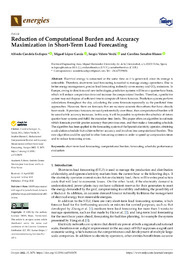Por favor, use este identificador para citar o enlazar este ítem:
https://hdl.handle.net/11000/34521Registro completo de metadatos
| Campo DC | Valor | Lengua/Idioma |
|---|---|---|
| dc.contributor.author | López García, Miguel | - |
| dc.contributor.author | Candela Esclapez, Alfredo | - |
| dc.contributor.author | VALERO, SERGIO | - |
| dc.contributor.author | Senabre, Carolina | - |
| dc.contributor.other | Departamentos de la UMH::Ingeniería Mecánica y Energía | es_ES |
| dc.date.accessioned | 2025-01-15T19:39:39Z | - |
| dc.date.available | 2025-01-15T19:39:39Z | - |
| dc.date.created | 2022 | - |
| dc.identifier.citation | Energies | es_ES |
| dc.identifier.issn | 1996-1073 | - |
| dc.identifier.uri | https://hdl.handle.net/11000/34521 | - |
| dc.description.abstract | Electrical energy is consumed at the same time as it is generated, since its storage is unfeasible. Therefore, short-term load forecasting is needed to manage energy operations. Due to better energy management, precise load forecasting indirectly saves money and CO2 emissions. In Europe, owing to directives and new technologies, prediction systems will be on a quarter-hour basis, which will reduce computation time and increase the computational burden. Therefore, a predictive system may not dispose of sufficient time to compute all future forecasts. Prediction systems perform calculations throughout the day, calculating the same forecasts repeatedly as the predicted time approaches. However, there are forecasts that are no more accurate than others that have already been made. If previous forecasts are used preferentially over these, then computational burden will be saved while accuracy increases. In this way, it will be possible to optimize the schedule of future quarter-hour systems and fulfill the execution time limits. This paper offers an algorithm to estimate which forecasts provide greater accuracy than previous ones, and then make a forecasting schedule. The algorithm has been applied to the forecasting system of the Spanish electricity operator, obtaining a calculation schedule that achieves better accuracy and involves less computational burden. This new algorithm could be applied to other forecasting systems in order to speed up computation times and to reduce forecasting errors. | es_ES |
| dc.format | application/pdf | es_ES |
| dc.format.extent | 18 | es_ES |
| dc.language.iso | eng | es_ES |
| dc.publisher | MDPI | es_ES |
| dc.relation.ispartofseries | 15 | es_ES |
| dc.relation.ispartofseries | 10 | es_ES |
| dc.rights | info:eu-repo/semantics/openAccess | es_ES |
| dc.rights | Attribution-NonCommercial-NoDerivatives 4.0 Internacional | * |
| dc.rights.uri | http://creativecommons.org/licenses/by-nc-nd/4.0/ | * |
| dc.subject | short-term load forecasting | es_ES |
| dc.subject | computational burden | es_ES |
| dc.subject | forecasting schedule | es_ES |
| dc.subject | performance evaluation | es_ES |
| dc.subject.other | CDU::6 - Ciencias aplicadas::62 - Ingeniería. Tecnología::621 - Ingeniería mecánica en general. Tecnología nuclear. Electrotecnia. Maquinaria | es_ES |
| dc.title | Reduction of Computational Burden and Accuracy Maximization in Short-Term Load Forecasting | es_ES |
| dc.type | info:eu-repo/semantics/article | es_ES |
| dc.relation.publisherversion | https://doi.org/10.3390/en15103670 | es_ES |

Ver/Abrir:
energies-15-03670-v2.pdf
3,32 MB
Adobe PDF
Compartir:
 La licencia se describe como: Atribución-NonComercial-NoDerivada 4.0 Internacional.
La licencia se describe como: Atribución-NonComercial-NoDerivada 4.0 Internacional.
.png)